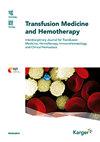Efficient Chimeric Antigen Receptor T-Cell Generation Starting with Leukoreduction System Chambers of Thrombocyte Apheresis Sets
IF 1.9
4区 医学
Q3 HEMATOLOGY
引用次数: 0
Abstract
Introduction: Primary human blood cells represent an essential model system to study physiology and disease. However, human blood is a limited resource. During healthy donor plateletpheresis, the leukoreduction system chamber (LRSC) reduces the leukocyte amount within the subsequent platelet concentrate through saturated, fluidized, particle bed filtration technology. Normally, the LRSC is discarded after apheresis is completed. Compared to peripheral blood, LRSC yields 10-fold mononuclear cell concentration. Methods: To explore if those retained leukocytes are attractive for research purposes, we isolated CD3+ T cells from the usually discarded LRSCs via density gradient centrifugation in order to manufacture CD19-targeted chimeric antigen receptor (CAR) T cells. Results: Immunophenotypic characterization revealed viable and normal CD4+ and CD8+ T-cell populations within LRSC, with low CD19+ B cell counts. Magnetic-activated cell sorting (MACS) purified CD3+ T cells were transduced with CD19 CAR-encoding lentiviral self-inactivating vectors using concentrated viral supernatants. Robust CD19 CAR cell surface expression on transduced T cells was confirmed by flow cytometry. CD19 CAR T cells were further enriched through anti-CAR MACS, yielding 80% CAR+ T-cell populations. In vitro CAR T cell expansion to clinically relevant numbers was achieved. To prove functionality, CAR T cells were co-incubated with the human CD19+ B cell precursor leukemia cell line Nalm6. Compared to unmodified T cells, CD19 CAR T cells effectively eradicated Nalm6 cells. Conclusion: Taken together, we can show that lymphocytes isolated from LRSCs of plateletpheresis sets can be efficiently used for the generation of functional CAR T cells for experimental purposes.高效嵌合抗原受体t细胞生成开始与白细胞诱导系统室的血小板分离装置
& lt; b> & lt; i>简介:& lt; / i> & lt; / b>人原代血细胞是研究生理和疾病的重要模型系统。然而,人类血液是一种有限的资源。在健康供体采血小板过程中,白细胞诱导系统腔室(LRSC)通过饱和、流态化、颗粒床过滤技术减少随后血小板浓缩物中的白细胞数量。正常情况下,在分离完成后,LRSC将被丢弃。与外周血相比,LRSC产生10倍的单核细胞浓度。& lt; b> & lt; i>方法:& lt; / i> & lt; / b>为了探索这些保留的白细胞是否对研究目的有吸引力,我们通过密度梯度离心从通常丢弃的LRSCs中分离出CD3+ T细胞,以制造cd19靶向嵌合抗原受体(CAR) T细胞。& lt; b> & lt; i>结果:& lt; / i> & lt; / b>免疫表型表征显示LRSC内存活和正常的CD4+和CD8+ t细胞群,CD19+ B细胞计数低。磁活化细胞分选(MACS)纯化的CD3+ T细胞用CD19 car编码慢病毒自灭活载体使用浓缩病毒上清转导。流式细胞术证实CD19 CAR细胞表面在转导的T细胞上表达稳健。通过抗CAR - MACS进一步富集CD19 CAR - T细胞,产生80%的CAR+ T细胞群。体外CAR - T细胞扩增达到临床相关数量。为了证明功能,CAR - T细胞与人类CD19+ B细胞前体白血病细胞系Nalm6共孵育。与未经修饰的T细胞相比,CD19 CAR - T细胞有效地根除了Nalm6细胞。& lt; b> & lt; i>结论:& lt; / i> & lt; / b>综上所述,我们可以证明,从血小板采集集的LRSCs中分离的淋巴细胞可以有效地用于生成功能性CAR - T细胞,用于实验目的。
本文章由计算机程序翻译,如有差异,请以英文原文为准。
求助全文
约1分钟内获得全文
求助全文
来源期刊
CiteScore
4.00
自引率
9.10%
发文量
47
审稿时长
6-12 weeks
期刊介绍:
This journal is devoted to all areas of transfusion medicine. These include the quality and security of blood products, therapy with blood components and plasma derivatives, transfusion-related questions in transplantation, stem cell manipulation, therapeutic and diagnostic problems of homeostasis, immuno-hematological investigations, and legal aspects of the production of blood products as well as hemotherapy. Both comprehensive reviews and primary publications that detail the newest work in transfusion medicine and hemotherapy promote the international exchange of knowledge within these disciplines. Consistent with this goal, continuing clinical education is also specifically addressed.

 求助内容:
求助内容: 应助结果提醒方式:
应助结果提醒方式:


